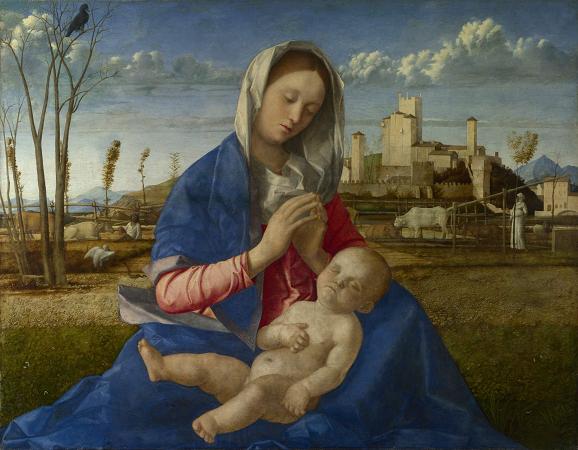Feast of Gods (1514). Oil on canvas. 170 x 188. The Feast of the Gods is an oil painting by the Italian Renaissance master Giovanni Bellini, with substantial additions in stages to the left and center landscape by Dosso Dossi and Titian. It is one of the few mythological pictures by the Venetian artist. Completed in 1514, it was his last major work. It is now in the National Gallery of Art in Washington D.C., which calls it one of the greatest Renaissance paintings in the United States. The painting is the first major depiction of the subject of the Feast of the Gods in Renaissance art, which was to remain in currency until the end of Northern Mannerism over a century later. It has several similarities to another, much less sophisticated, treatment painted by the Florentine artist Bartolomeo di Giovanni in the 1490s, now in the Louvre. The painting is signed by an inscription on the fictive paper attached to the wooden tub at the lower right: joannes bellinus venetus, and his payment that year is recorded. Based on a narrative by Ovid, it is the earliest of a cycle of paintings, all major works, on mythological subjects produced for Alfonso, I d'Este, the Duke of Ferrara, for his camerino d'alabastro in the Castello Estense, Ferrara. The subjects had been chosen by 1511, by the Renaissance humanist Mario Equicola, then working for the Duke's sister Isabella d'Este, and instructions apparently including some sketches were sent to the artists. Later commissions were four large Titians, and ten smaller works by Dosso Dossi, probably placed above them. The three surviving Titians painted for the room are Bacchus and Ariadne, The Bacchanal of the Andrians and The Worship of Venus. It had been suggested that Bellini made a preliminary set of alterations before or soon after 1514 to make the painting more compatible with the original Latin of Ovid, having previously been working from an Italian Ovidio volgarizzato version, and that at this point Bellini changed most of the characters to gods rather than people from Thebes, giving them attributes and lower necklines for the women. But this view was based on a misunderstanding of the early x-rays taken in 1956. It is now thought that the figures are as originally painted by Bellini. Bellini died in 1516, soon after completing the painting, and some years later Dosso Dossi and perhaps Titian modified the landscape on the left to match it to his The Bacchanal of the Andrians, also in Alfonso's Camerino, adding the rocky hill behind the figures and the brighter foliage on a tree at the right. A more thorough reworking by Titian in about 1529 added more landscape, overpainting the earlier changes. But all the work on the figures remains Bellini's. A pheasant in a tree on the right, above Priapus, may have been painted by Alfonso himself, an amateur painter. The painting shows the incident of the attempted rape of Lotis. She was a nymph mentioned by Ovid, the daughter of Neptune or Nereus. During a festival in honor of Liber that she attended, Priapus tried to rape her while she was asleep, but she was awakened by a sudden cry of Silenus's ass and ran off, leaving Priapus in embarrassment as everyone else woke up too and became aware of his intentions. The story is shown at the edges of the composition, in a somewhat undramatic fashion presumably showing a moment shortly before the key incident, with Silenus and his ass at left and Priapus and Lotis at right. The subject had been depicted in the first illustrated edition of Ovid in Italian, published in Venice in 1497. Another depiction of this rare subject in a Venetian print of 1510 has a very similar pose for Lotis but places much greater emphasis on the erotic nature of the story, including Priapus's outsize penis, here only a hint under the drapery. The figures shown are usually taken to be: a satyr, Silenus with his ass, his ward Bacchus as a boy, Silvanus, Mercury with his caduceus and helmet, a satyr, Jupiter, a nymph serving, Cybele, Pan, Neptune, two standing nymphs, Ceres, Apollo, Priapus, Lotis. Some of the figures may be portraits of people at the Ferrara court, including Alfonso and his wife Lucrezia Borgia. Another suggestion is that the couple in the center, the male with his hand between the female's thighs, are a bridal pair, as shown by their intimacy and the quince she is holding, a fruit recommended for brides to increase their sexual appetites. If he is still Neptune, this would make her Amphitrite. The work is atypical of Renaissance mythological painting in the down to earth treatment of the main deities, which may be accounted for by the figures beginning as ordinary citizens of Thebes, and by Bellini's inexperience in the emerging conventions of mythological art.
more...














